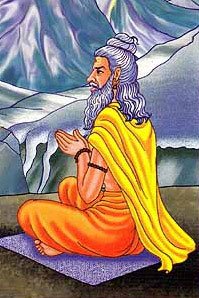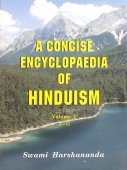Tirthayatra, Tīrthayātrā, Tirtha-yatra: 12 definitions
Introduction:
Tirthayatra means something in Hinduism, Sanskrit, Marathi. If you want to know the exact meaning, history, etymology or English translation of this term then check out the descriptions on this page. Add your comment or reference to a book if you want to contribute to this summary article.
In Hinduism
Purana and Itihasa (epic history)
Source: archive.org: Shiva Purana - English TranslationTīrthayātrā (तीर्थयात्रा) refers to a “pilgrimage”, according to the Śivapurāṇa 2.3.54 (“Description of the duties of the chaste wife”).—Accordingly, as a Brahmin lady said to Pārvatī: “[...] Without the permission of her husband she shall not go even on pilgrimage (tīrthayātrā). She shall eschew the desire to attend social festivities. If a women wants holy water she shall drink the same with which her husband’s feet have been washed. All holy rivers are present in that water. [...]”.
Source: Cologne Digital Sanskrit Dictionaries: The Purana IndexTīrthayātrā (तीर्थयात्रा).—A custom of going on pilgrimage. Vidura undertook one.1 Not fruitful to the unfaithful,2 of Gādhi; rules that one should not ride in a vehicle but walk;3 of Arjuna.4
- 1) Bhāgavata-purāṇa I. 13. 1.
- 2) Brahmāṇḍa-purāṇa III. 13. 135-6; 66. 43; IV. 9. 7.
- 3) Matsya-purāṇa 106. 3; 112. 20.
- 4) Ib. 244. 3.

The Purana (पुराण, purāṇas) refers to Sanskrit literature preserving ancient India’s vast cultural history, including historical legends, religious ceremonies, various arts and sciences. The eighteen mahapuranas total over 400,000 shlokas (metrical couplets) and date to at least several centuries BCE.
Kavya (poetry)
Source: Wisdom Library: KathāsaritsāgaraTīrthayātrā (तीर्थयात्रा) refers to a “pilgrimage to sacred places”, according to the Kathāsaritsāgara, chapter 49, where it is said: “pilgrimage to sacred places (tīrtayātra) is approved by the wise only for a man who cannot, according to the scriptures, attain happiness by performing the actions enjoined by the Vedas; but he who can acquire merit by offerings to the gods (deva), to the manes of deceased ancestors (pitṛ) and to the fire (agni), by vows (vrata) and muttering prayers (japa), what is the use of his wandering about on pilgrimages?”.

Kavya (काव्य, kavya) refers to Sanskrit poetry, a popular ancient Indian tradition of literature. There have been many Sanskrit poets over the ages, hailing from ancient India and beyond. This topic includes mahakavya, or ‘epic poetry’ and natya, or ‘dramatic poetry’.
General definition (in Hinduism)
Source: Shodhganga: Elements of Art and Architecture in the Trtiyakhanda of the Visnudharmottarapurana (h)Tīrthayātra (तीर्थयात्र) refers to the “system of pilgrimage”.—In Hinduism tīrthayātra (i.e., the system of pilgrimage) seems to be very auspicious, common and popular. The temple is a place where the devotees can get the environment to connect themselves with their lords. The Hindu temple consists of all the cosmic elements from fire to water, images of nature to deities, Gods remain feminine to masculine, kāma to artha, fleeting sounds and incense smells etc. by which one can celebrate life.
Languages of India and abroad
Marathi-English dictionary
Source: DDSA: The Molesworth Marathi and English Dictionarytīrthayātrā (तीर्थयात्रा).—f (S) Pilgrimage-going. Used comprehensively or laxly.
Source: DDSA: The Aryabhusan school dictionary, Marathi-Englishtīrthayātrā (तीर्थयात्रा).—f Pilgrimage-going.
Marathi is an Indo-European language having over 70 million native speakers people in (predominantly) Maharashtra India. Marathi, like many other Indo-Aryan languages, evolved from early forms of Prakrit, which itself is a subset of Sanskrit, one of the most ancient languages of the world.
Sanskrit dictionary
Source: DDSA: The practical Sanskrit-English dictionaryTīrthayātrā (तीर्थयात्रा).—a visit to a holy place, a pilgrimage.
Tīrthayātrā is a Sanskrit compound consisting of the terms tīrtha and yātrā (यात्रा).
Source: Cologne Digital Sanskrit Dictionaries: Benfey Sanskrit-English DictionaryTīrthayātrā (तीर्थयात्रा).—f. pilgrimage to holy places, [Pañcatantra] 117, 10.
Tīrthayātrā is a Sanskrit compound consisting of the terms tīrtha and yātrā (यात्रा).
Source: Cologne Digital Sanskrit Dictionaries: Cappeller Sanskrit-English DictionaryTīrthayātrā (तीर्थयात्रा).—[feminine] visit to a sacred shrine or bathing-place, pilgrimage.
Source: Cologne Digital Sanskrit Dictionaries: Monier-Williams Sanskrit-English Dictionary1) Tīrthayātrā (तीर्थयात्रा):—[=tīrtha-yātrā] [from tīrtha > tīra] f. = -caryā, [Mahābhārata; Bhāgavata-purāṇa; Pañcatantra] etc.
2) [v.s. ...] Name of [Śiva-purāṇa ii, 20]
[Sanskrit to German]
Sanskrit, also spelled संस्कृतम् (saṃskṛtam), is an ancient language of India commonly seen as the grandmother of the Indo-European language family (even English!). Closely allied with Prakrit and Pali, Sanskrit is more exhaustive in both grammar and terms and has the most extensive collection of literature in the world, greatly surpassing its sister-languages Greek and Latin.
See also (Relevant definitions)
Partial matches: Tirtha, Yatra.
Starts with: Tirthayatrakritya, Tirthayatrapaddhati, Tirthayatraparva, Tirthayatraparvan, Tirthayatraprabandha, Tirthayatratattva, Tirthayatravarnana, Tirthayatravidhi.
Ends with: Kamalakaratirthayatra.
Full-text: Tirthayatravidhi, Tirthayatratattva, Tirthayatraparvan, Sarvatirthayatravidhi, Kamalakaratirthayatra, Anavritta, Urdhvarekha, Kamalakara, Mrigayatra, Pratishthita, Yatra, Kamalakara bhatta, Mahabharata.
Relevant text
Search found 15 books and stories containing Tirthayatra, Tīrthayātrā, Tirtha-yatra, Tīrtha-yātrā; (plurals include: Tirthayatras, Tīrthayātrās, yatras, yātrās). You can also click to the full overview containing English textual excerpts. Below are direct links for the most relevant articles:
Garga Samhita (English) (by Danavir Goswami)
Verse 8.11.9 < [Chapter 11 - The King of Prayers to Lord Balarāma]
Verse 4.13.3 < [Chapter 13 - The Story of the Demigoddesses]
Mahabharata (English) (by Kisari Mohan Ganguli)
Mahabharata (English Summary) (by Kisari Mohan Ganguli)
Tirtha-yatra Parva < [Book 3 - Vana Parva]
Chaitanya Bhagavata (by Bhumipati Dāsa)
Verse 1.9.203 < [Chapter 9 - Nityānanda’s Childhood Pastimes and Travels to Holy Places]
Verse 1.9.101 < [Chapter 9 - Nityānanda’s Childhood Pastimes and Travels to Holy Places]
Verse 1.9.102-104 < [Chapter 9 - Nityānanda’s Childhood Pastimes and Travels to Holy Places]
The Agni Purana (by N. Gangadharan)
Related products
